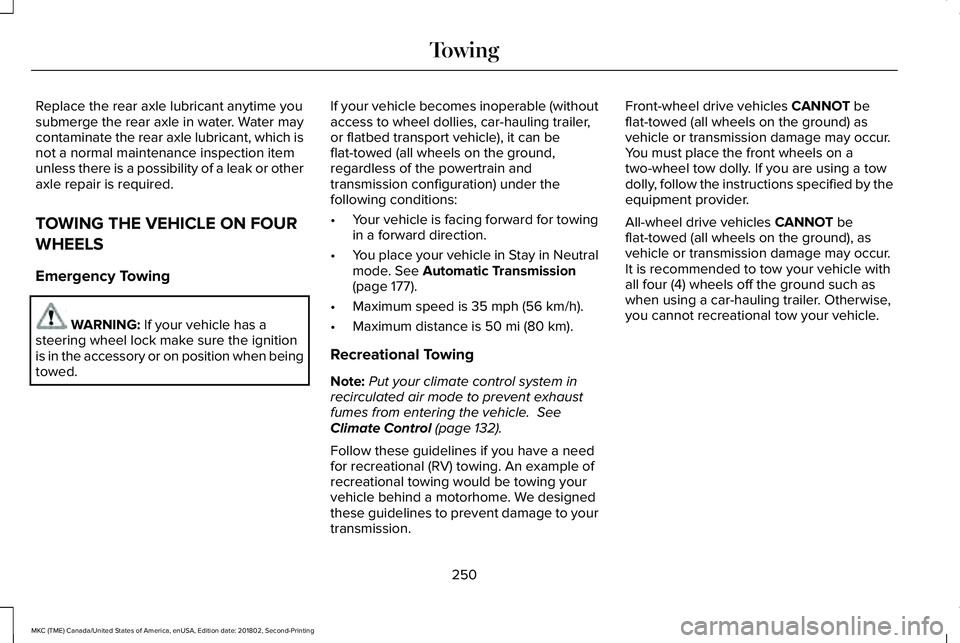2019 LINCOLN MKC emergency towing
[x] Cancel search: emergency towingPage 253 of 581

Replace the rear axle lubricant anytime yousubmerge the rear axle in water. Water maycontaminate the rear axle lubricant, which isnot a normal maintenance inspection itemunless there is a possibility of a leak or otheraxle repair is required.
TOWING THE VEHICLE ON FOUR
WHEELS
Emergency Towing
WARNING: If your vehicle has asteering wheel lock make sure the ignitionis in the accessory or on position when beingtowed.
If your vehicle becomes inoperable (withoutaccess to wheel dollies, car-hauling trailer,or flatbed transport vehicle), it can beflat-towed (all wheels on the ground,regardless of the powertrain andtransmission configuration) under thefollowing conditions:
•Your vehicle is facing forward for towingin a forward direction.
•You place your vehicle in Stay in Neutralmode. See Automatic Transmission(page 177).
•Maximum speed is 35 mph (56 km/h).
•Maximum distance is 50 mi (80 km).
Recreational Towing
Note:Put your climate control system inrecirculated air mode to prevent exhaustfumes from entering the vehicle. SeeClimate Control (page 132).
Follow these guidelines if you have a needfor recreational (RV) towing. An example ofrecreational towing would be towing yourvehicle behind a motorhome. We designedthese guidelines to prevent damage to yourtransmission.
Front-wheel drive vehicles CANNOT beflat-towed (all wheels on the ground) asvehicle or transmission damage may occur.You must place the front wheels on atwo-wheel tow dolly. If you are using a towdolly, follow the instructions specified by theequipment provider.
All-wheel drive vehicles CANNOT beflat-towed (all wheels on the ground), asvehicle or transmission damage may occur.It is recommended to tow your vehicle withall four (4) wheels off the ground such aswhen using a car-hauling trailer. Otherwise,you cannot recreational tow your vehicle.
250
MKC (TME) Canada/United States of America, enUSA, Edition date: 201802, Second-Printing
Towing
Page 341 of 581

When driving with the full-size dissimilarspare wheel and tire assembly, do not:
•Exceed 70 mph (113 km/h).
•Use more than one dissimilar sparewheel and tire assembly at a time.
•Use commercial car washing equipment.
•Use snow chains on the end of thevehicle with the dissimilar spare wheeland tire assembly.
The usage of a full-size dissimilar sparewheel and tire assembly can lead toimpairment of the following:
•Handling, stability and brakingperformance.
•Comfort and noise.
•Ground clearance and parking at curbs.
•Winter weather driving capability.
•Wet weather driving capability.
•All-wheel driving capability
When driving with the full-size dissimilarspare wheel and tire assembly additionalcaution should be given to:
•Towing a trailer.
•Driving vehicles equipped with a camperbody.
•Driving vehicles with a load on the cargorack.
Drive cautiously when using a full-sizedissimilar spare wheel and tire assembly andseek service as soon as possible.
Tire Change Procedure
WARNING: Never place anythingbetween the vehicle jack and the ground.
WARNING: Never place anythingbetween the vehicle jack and your vehicle.
WARNING: It is recommended that thewheels of the vehicle be chocked, and thatno person should remain in a vehicle that isbeing jacked.
WARNING: The jack supplied with thisvehicle is only intended for changing wheels.Do not use the vehicle jack other than whenyou are changing a wheel in an emergency.
WARNING: Check that the vehicle jackis not damaged or deformed and the threadis lubricated and clean.
WARNING: The jack should be usedon level firm ground wherever possible.
WARNING: Use only the specifiedjacking points. If you use other positions, youmay damage the body, steering, suspension,engine, braking system or the fuel lines.
WARNING: No person should placeany portion of their body under a vehicle thatis supported by a jack.
Note:The jack does not requiremaintenance or additional lubrication overthe service life of your vehicle.
338
MKC (TME) Canada/United States of America, enUSA, Edition date: 201802, Second-Printing
Wheels and Tires
Page 578 of 581

Tire Care..........................................................318Glossary of Tire Terminology...........................319Information About Uniform Tire QualityGrading..............................................................318Information Contained on the TireSidewall............................................................320Temperature A B C..............................................319Traction AA A B C................................................318Treadwear.............................................................318
Tire Pressure Monitoring System.............332Changing Tires With a Tire PressureMonitoring System.........................................333Understanding Your Tire Pressure MonitoringSystem .............................................................334
TiresSee: Wheels and Tires.......................................315
Towing a Trailer.............................................245Load Placement..................................................245
Towing the Vehicle on Four Wheels.......250Emergency Towing............................................250Recreational Towing..........................................250
Towing.............................................................245Traction Control.............................................195Principle of Operation........................................195
Trailer Sway Control....................................246Transmission Code Designation..............349Transmission...................................................177Transporting the Vehicle............................258
Type Approvals.............................................554Radio Frequency Certification Logos for BlindSpot Information System.............................562Radio Frequency Certification Logos for MidRange Radar....................................................557Radio Frequency Certification Logos forPassive Anti-Theft System...........................558Radio Frequency Certification Logos for RadioTransceiver Module......................................560Radio Frequency Certification Logos for SYNC3.........................................................................563Radio Frequency Certification Logos for TirePressure Monitoring Sensor(s)...................554Radio Frequency Certification Logos forWireless Charging.........................................563
U
Under Hood Overview................................288Unique Driving Characteristics..................163Universal Garage Door Opener................149HomeLink Wireless Control System...............149
USB Port..........................................................376Using Adaptive Cruise Control...................211Automatic Cancellation......................................214Blocked Sensor...................................................216Canceling the Set Speed..................................214Changing the Set Speed...................................214
Detection Issues..................................................215Following a Vehicle.............................................212Hilly Condition Usage........................................215Overriding the Set Speed.................................214Resuming the Set Speed...................................214Setting the Adaptive Cruise Speed................212Setting the Gap Distance..................................213Switching Adaptive Cruise Control Off..........215Switching Adaptive Cruise Control On..........212Switching to Normal Cruise Control...............218System Not Available.........................................216
Using All-Wheel Drive..................................183Driving in Special Conditions With All-WheelDrive...................................................................183
Using Cruise Control....................................210Switching Cruise Control Off.............................211Switching Cruise Control On............................210
Using MyKey With Remote StartSystems..........................................................63Using Snow Chains.......................................331Using Stability Control..................................197Using Traction Control.................................195Switching the System Off..................................195System Indicator Lights and Messages.........195Using a Switch.....................................................195Using the Information Display Controls........195
Using Voice Recognition............................396Audio Voice Commands...................................398
575
MKC (TME) Canada/United States of America, enUSA, Edition date: 201802, Second-Printing
Index